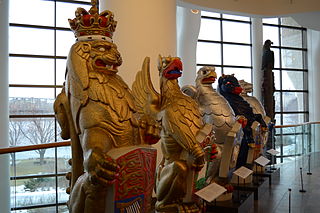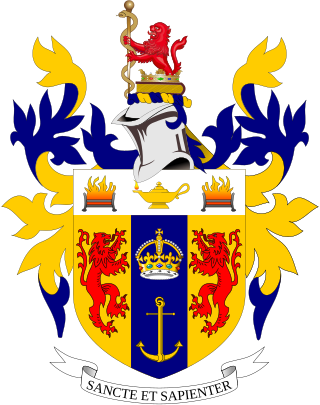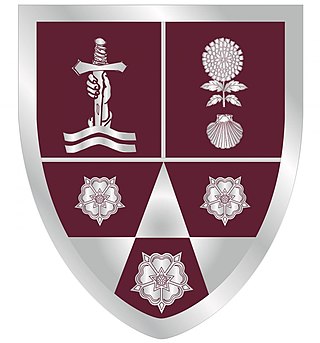
Mary of Teck was Queen of the United Kingdom and the British Dominions, and Empress of India, from 6 May 1910 until 20 January 1936 as the wife of King-Emperor George V.

The royal coat of arms of the United Kingdom is the arms of dominion of the British monarch, currently King Charles III. Variants of the royal arms are used by other members of the British royal family, by the Government of the United Kingdom, and some courts and legislatures in a number of Commonwealth realms.
King Edward's School or King Edward VI School may refer to:

The Worshipful Company of Drapers is one of the 111 livery companies of the City of London. It has the formal name The Master and Wardens and Brethren and Sisters of the Guild or Fraternity of the Blessed Mary the Virgin of the Mystery of Drapers of the City of London. More usually known simply as the Drapers' Company, it is one of the historic Great Twelve Livery Companies and was founded during the Middle Ages.

Dieu et mon droit, which means 'God and my right', is the motto of the monarch of the United Kingdom. It appears on a scroll beneath the shield of the version of the coat of arms of the United Kingdom. The motto is said to have first been used by Richard I (1157–1199) as a battle cry and presumed to be a reference to his French ancestry and the concept of the divine right of the monarch to govern. It was adopted as the royal motto of England by King Henry V (1386–1422) with the phrase "and my right" referring to his claim by descent to the French crown.
Semper fidelis is a Latin phrase that means "always faithful" or "always loyal". It is the motto of the United States Marine Corps, usually shortened to Semper Fi. It is also in use as a motto for towns, families, schools, and other military units.

The coat of arms of Ontario is the armorial emblem representing the Canadian province of Ontario. The arms contain symbols reflecting Ontario's British heritage, along with local symbols. At the upper part of the shield is the red cross of St. George, representing England. The lower portion of the shield features three golden maple leaves on a green background.

The coat of arms of Alberta, the heraldic symbol representing the Canadian province of Alberta, contains symbols reflecting Alberta's English heritage along with local symbols. The upper part of the shield features the red cross of Saint George. The lower portion of the shield depicts the Rocky Mountains, grass prairies, and wheat fields – representing Alberta's landscape.

From the 1340s to the 19th century, excluding two brief intervals in the 1360s and the 1420s, the kings and queens of England and Ireland also claimed the throne of France. The claim dates from Edward III, who claimed the French throne in 1340 as the sororal nephew of the last direct Capetian, Charles IV. Edward and his heirs fought the Hundred Years' War to enforce this claim, and were briefly successful in the 1420s under Henry V and Henry VI, but the House of Valois, a cadet branch of the Capetian dynasty, was ultimately victorious and retained control of France, except for Calais and the Channel Islands. English and British monarchs continued to prominently call themselves kings of France, and the French fleur-de-lis was included in the royal arms. This continued until 1802, by which time France no longer had any monarch, having become a republic. The Jacobite claimants, however, did not explicitly relinquish the claim.

The Queen's Beasts are ten heraldic statues representing the genealogy of Queen Elizabeth II, depicted as the Royal supporters of England. They stood in front of the temporary western annexe to Westminster Abbey for the Queen's coronation in 1953. Each of The Queen's Beasts consists of a heraldic beast supporting a shield bearing a badge or arms of a family associated with the ancestry of Queen Elizabeth II. They were commissioned by the British Ministry of Works from the sculptor James Woodford, who was paid the sum of £2,750 for the work. They were uncoloured except for their shields at the coronation. They are now on display in the Canadian Museum of History in Gatineau, Quebec.

A Royal Badge for Wales was approved in May 2008. It is based on the arms borne by the thirteenth-century Welsh prince Llywelyn the Great, with the addition of St Edward's Crown atop a continuous scroll which, together with a wreath consisting of the plant emblems of the four countries of the United Kingdom, surrounds the shield. The motto which appears on the scroll, PLEIDIOL WYF I'M GWLAD, is taken from the National Anthem of Wales and is also found on the Welsh designs for £1 coins minted from 1985 until 2000. The badge formerly appeared on the covers of Assembly Measures; since the 2011 referendum, it now appears on the cover of Acts passed by the Senedd and its escutcheon, ribbon and motto are depicted on the Welsh Seal.

Arnold School was an independent school in Blackpool, Lancashire, England, established on the Fylde coast in 1896 during the Victorian expansion of public boarding schools in England.
Frank Carter Duckworth MBE is a retired English statistician, and is one of the two statisticians who developed the Duckworth–Lewis method of resetting targets in interrupted one-day cricket matches. He attended King Edward VII School, Lytham, now part of King Edward VII and Queen Mary School, then went on to study physics and earned a PhD (1965) in metallurgy, both at the University of Liverpool. Prior to his retirement, he worked as a mathematical scientist for the English nuclear power industry. He was a consultant statistician to the International Cricket Council, and the editor of the Royal Statistical Society's monthly news magazine, RSS News, until he retired from both these roles in 2014. He also served on the editorial board of Significance before stepping down in 2010. In 2004 he delivered the Royal Statistical Society Schools Lecture, entitled Lies and Statistics.
The United Church Schools Trust (UCST) is a large education charity in the United Kingdom which owns and operates a group of 12 private schools. The charity is operating under the name United Learning as of 2012.

The Grey Coat Hospital is a Church of England secondary school with academy status for girls in Westminster, London, England. In 2013, it had 1064 pupils including 40 boys in the Sixth Form. It is a specialist Language College.

Hugh Arnold was an English stained glass artist. Arnold was educated at the Slade School of Fine Art before attending the London County Council (LCC) Central School of Arts and Crafts where he studied under Christopher Whall from 1989 to 1903. He designed stained glass windows for James Powell & Sons and also did some independent work. While an officer in the Northumberland Fusiliers, Arnold died on active service at Gallipoli in 1915.

The coat of arms of King's College London in London, England, are blazoned: on a Pale Azure between two Lions rampant respectant Gules an Anchor Gold ensigned by a Royal Crown proper on a Chief Argent an Ancient Lamp proper inflamed Gold between two Blazing Hearths also proper.

The coat of arms of Imperial College London is an heraldic emblem used by Imperial College London. Edward VII granted the college the arms on the 6 June 1908 by royal warrant. It is blazoned:
Per fesse in chief the Royal Arms of the United Kingdom of Great Britain and Ireland, in base or, an open book proper inscribed with the word "Scientia"

King Edward VII School (KES) or King Edward School Lytham was a grammar, direct grant grammar and independent school for boys, founded in 1908 and situated in the coastal town of Lytham St. Annes, Lancashire. The school was merged with Queen Mary School for girls in 1999, and was renamed to create the co-educational King Edward VII and Queen Mary School (KEQMS)

















